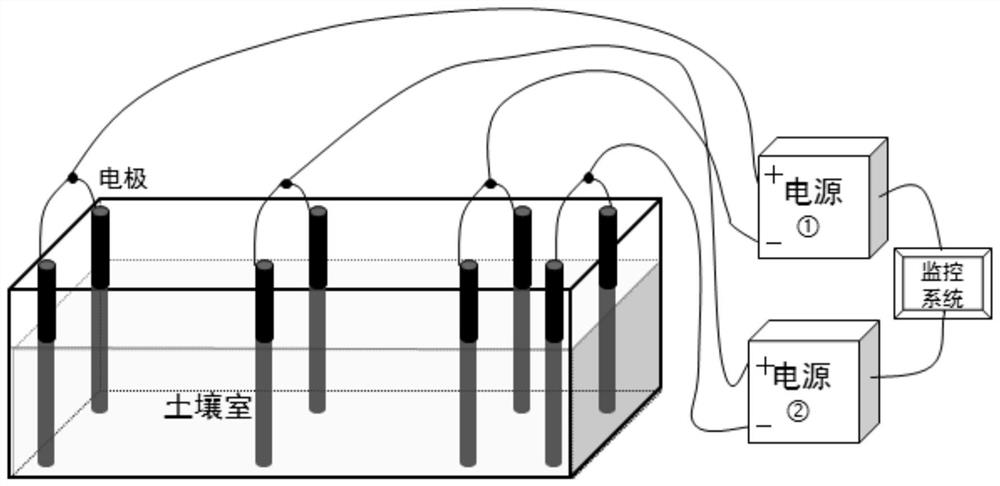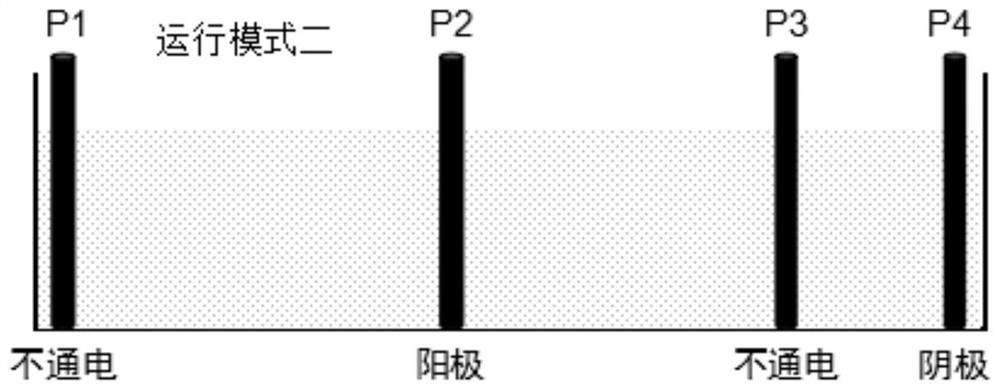Electrokinetic synergistic remediation method for composite polluted soil based on partitioned electric field
A collaborative repair and composite pollution technology, applied in the field of contaminated soil remediation, can solve problems such as secondary pollution, high-concentration site pollution is not applicable, and phytoremediation is slow.
- Summary
- Abstract
- Description
- Claims
- Application Information
AI Technical Summary
Problems solved by technology
Method used
Image
Examples
Embodiment 1
[0051] The polluted soil repaired in this example is self-combined Cd and pyrene composite polluted soil. The clean soil was collected from the 0-20cm topsoil in Shenbei New District, Liaoning Province, and the soil was loam. The soil from which stones and plant roots have been removed is naturally air-dried, passed through a 20-mesh sieve, and artificially prepared into composite polluted soil with Cd and pyrene concentrations of about 100 mg / kg. After the contaminated soil was air-dried, the soil pH was measured to be 6.1. The pyrene-degrading bacteria stored in the laboratory were activated and prepared into a suspension and mixed with the contaminated soil, and the soil humidity was adjusted to 30% with deionized water, and loaded into a soil chamber. The specific specifications of the soil chamber are: length 32cm, width 17cm, height 10cm. Add appropriate amount of deionized water to the soil during operation to balance water loss.
[0052] The repair device adopted in...
Embodiment 2
[0060] The difference from Example 1 is that the soil used in the experiment is compound polluted soil with Cd and n-hexadecane, the concentration of Cd is 200 mg / kg, and the concentration of n-hexadecane is 500 mg / kg. The total processing time is 60 days, the running time of mode 1 is 16 days; the running time of mode 2 is 14 days. After 60 days of treatment, 84.3% of Cd in the soil was enriched in R 2 area, the total removal rate of n-hexadecane in the soil reached 57.3%.
Embodiment 3
[0062] The difference from Examples 1 and 2 is that the pollutants in the soil are various heavy metals and organic matter. The soil used in the experiment is polluted soil around the smelter. The heavy metal pollutants in the soil are mainly Pb, Cd, Zn, Ni, Cu, etc., with concentrations of 98.73mg / kg, 8.64mg / kg, 105.52mg / kg, and 35.68mg / kg respectively. , 25.84mg / kg, organic pollutants are mainly polycyclic aromatic hydrocarbons, and the total concentration of 16 kinds of EPA priority control polycyclic aromatic hydrocarbons is 563mg / kg. The total processing time is 45 days.
[0063] According to the experiment, under the same pH condition, among the five heavy metals, the migration speed of Cu in the soil is the slowest, so the R 2 The enrichment amount of Cu in the area, and thus determine the running time of mode 1, that is, the mode 1 time T 1 = 25 days. According to R 3 The amount of Cu precipitation after the soil acid-base mutation surface stabilizes in the area is...
PUM
 Login to View More
Login to View More Abstract
Description
Claims
Application Information
 Login to View More
Login to View More - R&D
- Intellectual Property
- Life Sciences
- Materials
- Tech Scout
- Unparalleled Data Quality
- Higher Quality Content
- 60% Fewer Hallucinations
Browse by: Latest US Patents, China's latest patents, Technical Efficacy Thesaurus, Application Domain, Technology Topic, Popular Technical Reports.
© 2025 PatSnap. All rights reserved.Legal|Privacy policy|Modern Slavery Act Transparency Statement|Sitemap|About US| Contact US: help@patsnap.com



